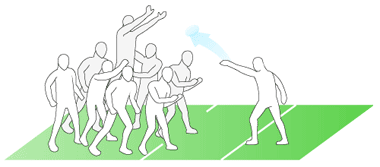In this article by TalkRugbyUnion, readers can learn about the rules and mechanics of a line-out in rugby union. A line-out is awarded when the ball is kicked into touch and requires each team to form a line of players across the pitch. The ball is thrown in from off the pitch by the hooker, and players attempt to catch it or pass it down to the scrum-half. The line-out is classified as over once the ball is passed out of the line or a maul is formed and moves over the line of touch. The article also mentions the importance of communication and codes used by the throwing-in team. Those interested in learning more about rugby union can check out TalkRugbyUnion’s guide.
What Is a Line-Out?
Used in rugby union, a line-out is awarded to a member of the opposing team if the ball is kicked into touch (out of the field of play) during a match. A line-out requires each team to form a line of players across the pitch at a distance of 1 metre apart from each other with the line of touch passing through the centre of the gap. The line-out must span between 5 and 15 m from the touchline where the ball is being thrown-in from. The ball is then thrown in from off the pitch by the hooker of the team in possession and the players attempt to catch the ball or to pass it down to the scrum-half, who is usually positioned just outside of the line-out in a close enough position to receive the ball once a member of their team has caught it.
The members of the team who are not in the line-out and are not the scrum-half must stand at least 10 m from the line-out. Once a player has caught the ball, they may hang on to it, allowing a maul to form, and the line-out is classified as being over once the maul moves over the line of touch. Otherwise the line-out is over when the ball is passed out of the line to a player waiting outside the line-out or when a player moves away from the line-out with the ball.
The way in which the ball was kicked into touch determines where the line-out is taken from. If the ball bounces into touch, the ball is thrown-in from the place the ball left the field but, if it is kicked into touch, the ball is thrown-in where the kick was taken from. During the formation of a line-out, the players of the throwing-in team will speak to each other by code before the hooker throws the ball in order to communicate to all members of the team (and especially the hooker) who the ball should thrown to, what that player will do with the ball if they catch it and what their follow-up tactic will be. The line-out code used is usually relatively complex to prevent the opposing team from anticipating the tactic.
Rules of a line-out
- Each team must have a minimum of two players and a maximum of fourteen players in the line-out (the fifteenth player must throw the ball in).
- The throwing-in team may choose how many players from each team will be included in the line-out (seven players on each team is the usual number selected).
- The opposing team are not permitted to have more players in the line-out than the throwing-in team but they are permitted to have less.
- Team-mates may support a player who jumps up from the ball but officially they are not allowed to lift another player (a rule that is rarely upheld).
- Players are not allowed to tackle a player of the opposing team when they are jumping for the ball.
- Players are not allowed to use a member of the opposition as support when they are jumping to catch the ball.
- A player jumping for the ball may not use the outside of their arm to move the ball away from the line-out.
- No player is allowed to move into the gap between the opposing lines unless they are in the act of jumping for the ball.
- Players are not permitted to charge at another player, hold them down or push them during a line-out.
- The ball must travel for a minimum of 5 metres before a player in the line-out is permitted to catch the ball.
- The hooker throwing-in the ball is permitted to throw the ball so that it travels over the line-out and 15 metres from the throw-in point. If this happens, one of the players who is positioned 10 metres from the line-out may run forward to catch the ball, but if the ball does not travel the full 15 metres and a player moves beyond 10 metres, they will be penalised.
- The hooker must stand behind the touch line when making their throw.
- If the hooker does not throw the ball in a straight line, the throw-in will be taken again with the opposing team in possession.
- If an offence is committed, the referee may award a penalty or free kick to a member of the opposing team.

